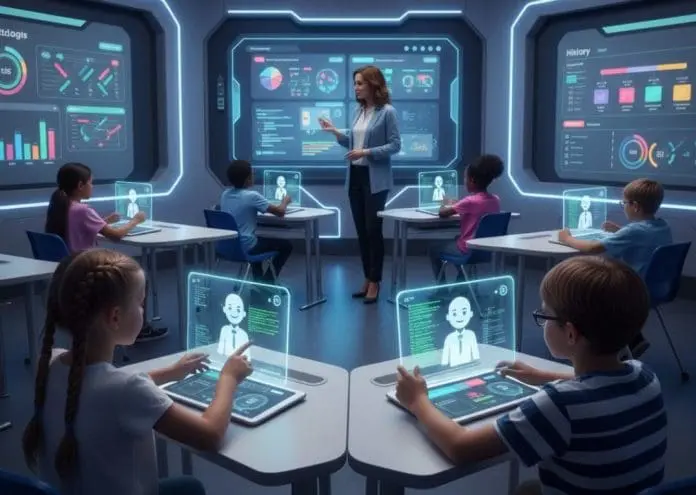Copyright ghanamma

Countries across the world are racing to integrate artificial intelligence education into primary and secondary schools, transforming classrooms into strategic battlegrounds for technological supremacy as nations compete to prepare the next generation for an AI driven economy. China launched AI courses for students as young as six in Beijing schools starting fall 2025, mandating at least eight hours of instruction annually. Chinese Education Minister Huai Jinpeng calls AI a golden key for the education system, signaling the country’s commitment to cultivating talent from the earliest grades. Beijing hopes to replicate success seen at Zhejiang University, which produced DeepSeek founder Liang Wenfeng and Unitree Robotics founder Wang Xingxing. Primary schools in Beijing focus on experiential courses introducing AI concepts, while junior high schools emphasize cognitive courses helping students apply AI in daily life, and senior high schools offer practical courses enhancing AI application and innovation. The curriculum covers chatbot use, algorithm understanding, and AI ethics alongside traditional subjects. India announced plans to introduce Artificial Intelligence and Computational Thinking into the national curriculum from Class 3 onwards beginning the 2026–27 academic year. Education Secretary Sanjay Kumar emphasized that AI should be treated as a basic universal skill integrated with the theme The World Around Us. The Central Board of Secondary Education established an expert committee chaired by Professor Karthik Raman of IIT Madras to develop a comprehensive AI curriculum. India operates 1.5 million schools serving over 260 million students, making this the largest educational transformation globally by scale. Resource materials, handbooks, and digital content are scheduled for completion by December 2025. The initiative builds on India’s Youth for Unnati and Vikas with AI (YUVAi) program, developed with Intel India, which engages students aged 8 to 12 in hands on AI activities combining technical skills with social emotional learning. Estonia partnered with OpenAI to deploy ChatGPT Edu to all secondary school students and teachers, with 10th and 11th graders gaining access beginning September 2025. This marks the first government deployment ensuring students across an entire nation have access to this technology. The AI Leap program will initially include 20,000 high schoolers and 3,000 teachers, expanding to vocational schools and an additional 38,000 students in 2026. Estonia already ranks among the top 15 countries globally for ChatGPT usage, with approximately one active account for every four citizens. The government plans significant investments in teacher training to support the rollout. South Korea introduced AI powered digital textbooks in March 2025 for math, English, and computer science, though the program faced technical problems and criticism from parents concerned about screen exposure. The National Assembly later reclassified AI digital textbooks as supplementary materials rather than core educational content, effectively removing legal and financial foundations for their mandatory use. California became the first US state to mandate AI literacy, requiring schools to incorporate artificial intelligence into math, science, and history curricula with implementation beginning after January 2025. The Instructional Quality Commission will update curriculum frameworks when next revised to include how AI works, its applications, limitations, ethical issues and real world impacts. However, AI education in the United States remains highly decentralized compared to the unified national strategies deployed by China and India. New Jersey and Indiana have allocated millions for AI teacher training, while Utah introduced specialized technology positions to deploy classroom AI tools. In Europe, the AI Classroom initiative operates across 50 schools in six countries including the United Kingdom, Spain, Italy, Bulgaria, Finland and Sweden, with Ireland and Poland set to join. The project combines education focused devices with Microsoft Copilot and Google Gemini embedded into classroom use, helping teachers plan lessons with artificial intelligence and analyze test results through data science. Hong Kong mandates 10 to 14 hours of AI education for junior secondary students, focusing on algorithmic fairness and the social impact of emerging technologies. Australia, the United Arab Emirates, and Finland emphasize AI ethics and transparency in their educational frameworks. The Organisation for Economic Co-operation and Development (OECD) estimates that by 2035, countries integrating AI literacy into primary education could see a 15 to 20 percent increase in workforce productivity compared to those that do not. This projection drives nations to treat AI education as essential infrastructure rather than optional enrichment. Critics raise concerns about the pace and ethics of implementation. Questions persist about whether young students are learning to use AI responsibly or becoming overly dependent on algorithmic thinking. Infrastructure challenges in rural areas, particularly in India, could hinder equitable access despite ambitious national plans. The global push reflects recognition that AI literacy will shape how the next generation understands intelligence, agency, and truth in a world increasingly mediated by artificial systems. Nations racing to embed these skills early believe they are positioning themselves to lead rather than follow in the emerging AI economy.



